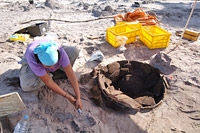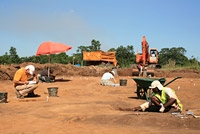Research project
Archaeology of the Lower Maroni River
The application of compliance archaeology techniques such as mechanical large scale excavations where large quantities of data are gathered in relatively little time (and relatively inexpensively) and a firm post-excavation research phase yielded a whole new body of archaeological evidence.
- Funding
-
 Inrap
Inrap

Martijn van den Bel has been working in archaeology in French Guiana since 1993 and eventually moved there in 2004 as a project leader for Inrap (Institute national de recherches archéologiques preventives). Inrap, a public body executing compliance archaeology in France, including the overseas departments, co-funds Martijn’s PhD reseach. Since 2003, many archaeological projects all over French Guiana have yielded an expanding archaeological data set, overwhelming the hitherto scant archaeology of the coastal Guianas, when compared for example to the Antilles.
 Many anthropogenic features revealed the presence of activity areas, burial grounds, irrigation but also
terra preta and complex stratigraphy on site. Radiocarbon dates, geomorphology, micromorphology, and chemical analysis has been realised to better understand site formation processes and different occupations per site. Large quantities of artefacts have been studied, both lithic and ceramic material, revealing hitherto unknown ceramic series for the Maroni river drainage. Additional analysis on starch grains of ceramic and lithic artefacts evidence the early use of maize and incipient ceramics during the third millennium BC (Early Ceramic Age).
Many anthropogenic features revealed the presence of activity areas, burial grounds, irrigation but also
terra preta and complex stratigraphy on site. Radiocarbon dates, geomorphology, micromorphology, and chemical analysis has been realised to better understand site formation processes and different occupations per site. Large quantities of artefacts have been studied, both lithic and ceramic material, revealing hitherto unknown ceramic series for the Maroni river drainage. Additional analysis on starch grains of ceramic and lithic artefacts evidence the early use of maize and incipient ceramics during the third millennium BC (Early Ceramic Age).
 The Late Ceramic Age is (AD 900 – 1500), probably the best known period in coastal French Guiana and Suriname, has also been identified on the Maroni but its ceramic series differ somewhat from existing ceramic complexes. The discovery of important urn burial grounds near Iracoubo evidenced another important cultural characteristic of Late Ceramic societies.
The Late Ceramic Age is (AD 900 – 1500), probably the best known period in coastal French Guiana and Suriname, has also been identified on the Maroni but its ceramic series differ somewhat from existing ceramic complexes. The discovery of important urn burial grounds near Iracoubo evidenced another important cultural characteristic of Late Ceramic societies.
The latter population experienced the European encounter and their society was modified profoundly by the end of the 17 th century when we can read the first extensive journals on Amerindian material culture. Diseases and enslavement diminished the indigenous population of the coastal Guianas and multiple (Jesuit) missionaries created a hodge-podge of different groups, resulting eventually in the ethnogenesis of the modern Amerindian groups, such as the Kali’na, Lokono and Palikur. A ceramic tradition clearly survived until today , its origins perhaps revealed by the excavations of historic Amerindian sites, such as Eva near Malmanoury.
